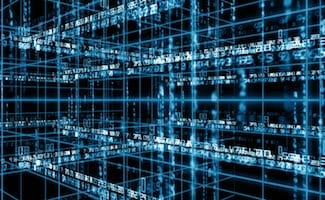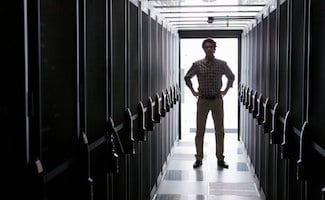https://vimeo.com/262452922
Teachers and students learning to navigate through a technological world  Anne Pasco is a psychologist by training and became a networking technology guru at a time when the concept and the title didn’t even exist. After becoming a social studies teacher in a large school district outside of Chicago, her professional worlds collided to everyone’s benefit. “As technology has changed, it has changed education,” she says. “I found myself in a unique position where my skill sets on all sides were needed to help teachers navigate that shift.”
Anne Pasco is a psychologist by training and became a networking technology guru at a time when the concept and the title didn’t even exist. After becoming a social studies teacher in a large school district outside of Chicago, her professional worlds collided to everyone’s benefit. “As technology has changed, it has changed education,” she says. “I found myself in a unique position where my skill sets on all sides were needed to help teachers navigate that shift.”
When the Community Unit School District 300 (CUSD 300) introduced edtech to the staff, they tried to immerse teachers in the tools immediately. They accomplished it fairly quickly with a one-to-one implementation of 22,000 students in two years. Moving very fast with a full learning management system and digital curriculum, Anne, and the district had to build teachers’ capacity on the run as they all were traveling down that path.
Anne still sees a disconnect among teachers about the digital divide between generations. For some, the solution is a simple explanation and definition of what is “digital literacy.” When they understand that every student is going to need to access a simple bank account online in their lives, they start to get it. “You have to ask the teachers, what is it that you want kids to do?” Anne says. “What does education and digital literacy mean for the teacher and the student in the real world? How does that translate into the classroom? And those questions helped us reframe the conversation about what ‘college-and-career-ready’ actually means to today’s student.”
 After all, being college-and-career-ready isn’t just about merely meeting the state assessment standards anymore. Students not only need to know how they learn but also how to access and use available tools and resources on college campuses without having to go to an adult to ask for help. Digital literacy helps instill confidence in teachers to ensure students become not only college-and-career-ready but more importantly, confident and self-assured as they leave the safe confines of home to embark on their journey through life. Digital literacy helps students navigate through the world.
After all, being college-and-career-ready isn’t just about merely meeting the state assessment standards anymore. Students not only need to know how they learn but also how to access and use available tools and resources on college campuses without having to go to an adult to ask for help. Digital literacy helps instill confidence in teachers to ensure students become not only college-and-career-ready but more importantly, confident and self-assured as they leave the safe confines of home to embark on their journey through life. Digital literacy helps students navigate through the world.
Digital literacy is essential in the classroom because technology tools help show kids what they know and don’t know many times over before teachers even see the results of metrics indicating the learning gaps. It allows teachers to see an understanding by the student of the communication and the lesson. The technology becomes the facilitator, helping both the teacher and the student learn. Anne notes that the technology also helps the student advocate. “We have a lot of students who advocate via email who maybe wouldn’t raise their hands in a classroom,” she says.
 While we’d like to think that the education industry as a whole is on the cutting edge in understanding its place in the greater good of the community and the development of student college and career readiness, things have changed over the last decade. Anne thinks we’ve done a disservice to educators over the years by not giving them time to reflect and process. “If you look at Moore’s law and how quickly technology has regenerated itself and doubled, we haven’t given educators time to pause, reflect and to look at how the world actually functions,” Anne says. “We hit them with priority standards, assessment data and understanding that data but we don’t really let them take the outside world and put it into education and look at how all those things intersect.”
While we’d like to think that the education industry as a whole is on the cutting edge in understanding its place in the greater good of the community and the development of student college and career readiness, things have changed over the last decade. Anne thinks we’ve done a disservice to educators over the years by not giving them time to reflect and process. “If you look at Moore’s law and how quickly technology has regenerated itself and doubled, we haven’t given educators time to pause, reflect and to look at how the world actually functions,” Anne says. “We hit them with priority standards, assessment data and understanding that data but we don’t really let them take the outside world and put it into education and look at how all those things intersect.”
Young teachers often come in excited and ready to learn, eager to embrace all that the district will teach them, but inevitably there winds up being a variation between what teachers learn and what they end up doing in the real world of the classroom. Administrations and mentors need to remember that just like any career, there’s a learning curve. “But I don’t see a huge disconnect between older teachers and younger teachers,” Anne says. “It’s really more about what Carol Dweck would tell us between a growth mindset and fixed mindset.”
“Anyone who comes in with a growth mindset of ‘I’m here, I can learn more, teach me new things- let’s go for it,’ tends to do pretty well through this transition,” Anne says. “People who have a fixed mindset, no matter what their age is, tend to struggle a little bit more.”
About Anne Pasco
 Anne Pasco is the Director of Digital Literacy and Innovation in the Community Unit School District 300 outside of Chicago. She is an experienced instructional leader in EdTech with a demonstrated history of working in the primary/secondary education industry. She is skilled in Secondary Education, Instructional Design, Change Agent, Classroom Management, Interventions, Lesson Planning, and Educational Technology. She is a passionate believer in student-centric and visible learning to promote authentic experiences which result in greater student knowledge and achievement.
Anne Pasco is the Director of Digital Literacy and Innovation in the Community Unit School District 300 outside of Chicago. She is an experienced instructional leader in EdTech with a demonstrated history of working in the primary/secondary education industry. She is skilled in Secondary Education, Instructional Design, Change Agent, Classroom Management, Interventions, Lesson Planning, and Educational Technology. She is a passionate believer in student-centric and visible learning to promote authentic experiences which result in greater student knowledge and achievement.
Anne has a BA in Psychology from Wake Forest University and a Masters of Education from the American College of Education.
Follow Anne Pasco on Twitter.
